英文介绍-开封
- 格式:ppt
- 大小:10.03 MB
- 文档页数:54
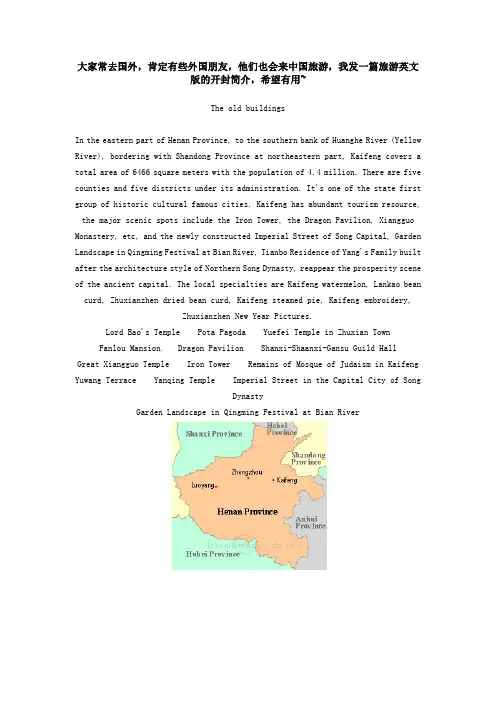
大家常去国外,肯定有些外国朋友,他们也会来中国旅游,我发一篇旅游英文版的开封简介,希望有用~The old buildingsIn the eastern part of Henan Province, to the southern bank of Huanghe River (Yellow River), bordering with Shandong Province at northeastern part, Kaifeng covers a total area of 6466 square meters with the population of 4.4 million. There are five counties and five districts under its administration. It's one of the state first group of historic cultural famous cities. Kaifeng has abundant tourism resource, the major scenic spots include the Iron Tower, the Dragon Pavilion, Xiangguo Monastery, etc, and the newly constructed Imperial Street of Song Capital, Garden Landscape in Qingming Festival at Bian River, Tianbo Residence of Yang's Family built after the architecture style of Northern Song Dynasty, reappear the prosperity scene of the ancient capital. The local specialties are Kaifeng watermelon, Lankao bean curd, Zhuxianzhen dried bean curd, Kaifeng steamed pie, Kaifeng embroidery,Zhuxianzhen New Year Pictures.Lord Bao's Temple Pota Pagoda Yuefei Temple in Zhuxian TownFanlou Mansion Dragon Pavilion Shanxi-Shaanxi-Gansu Guild Hall Great Xiangguo Temple Iron Tower Remains of Mosque of Judaism in Kaifeng Yuwang Terrace Yanqing Temple Imperial Street in the Capital City of Song Dynasty Garden Landscape in Qingming Festival at Bian RiverIron Tower (Northeast No.24) {Recommendation index:*****[An old nice park]}Located in the Iron Tower Park, northeastern corner of Kaifeng City, it's also known as "Kaibao Temple Tower ", since its whole body was covered by dark brown glazed tiles,, from a distance, it looks like iron color, hence, so it got the name of Iron Tower . The Tower was built in 1049 A.D the first year of Huangyou of Northern Song Dynasty, has history of more than 900 years, in 1961, it was designated by the State Council as the key antique unit under special protection. The Tower is an octagonal building of 13 storeys with a height of 55.88 meters, the width of each side at the base is 4.16 meters, and it is decreasing from the base to the top levels. The body of the tower was erected with colorful pattern bricks with over 50 designs of the celestial flying ladies, the unicorn, Buddha, musician and dancers, lions, etc, the style is charming, vivid and lifelike, it's worthy to be the artistic masterpiece of Song Dynasty. The Iron Tower is well known at home and abroad with its unique art of architecture, the design is fine and excellent, strong in structure, it withstands numerous attacks of earthquake, floods but not dropped down .Great Xiangguo Temple (center N0.14) {Recommendation index:****[Imperial temple]}Located at the center of Kaifeng City, it is one of renowned Buddhist Monastery in China firstly constructed in 555 AD during the period of Northern Qi Dynasty. It was firstly named Jianguo Monastery, in 712 AD, it was given the name the Great Xiangguo Temple by the Emperor Reizong in memory of his ascending to the throne of emperor from the former position of King Xiang. During the Northern Song Dynasty, it was deeply worshipped and respected by the royal family enlarging for several times, it once occupied an area as large as 500 mu of land, with 64 meditation yards, law yards under its administration, with more than 1,000 monks, being the biggest monastery in the capital city and the center of national Buddhist activities. Later, it was destroyed by floods and wars, and restored in the 10th year (1671 AD) under the reign of Emperor Kangxi in Qing Dynasty. At present, the existing construction includes the Hall of Celestial King, the Hall of Great Marhavira, the Hall of Buddhism Inscriptions, Goddess of Mercy with thousand hands and eyes, etc. In August, 1992, the Buddhist activities were restored, the drum and bell towers were rebuilt. The layout of entire monastery is closely and properly arranged with a magnificent look.Dragon Pavilion (North No.3){Recommendation index:*****[Northern Song Dynasty imperial palace]}Located at the northwestern corner of Kaifeng City, Dragon Pavilioncovers an area of over 1300 mu, of which, 710 mu is water area. The whole park includes the mid-gate, the jade-belt bridge, imperial gate, screen, the imperial court room, dragon pavilion, the ruin of imperial palace gate of the Northern Song Dynasty, the tablet pavilion, the north gate and east gate, the building groups of longevity palace of Qing Dynasty. The other garden landscape also include Pan Lake and Yang Lake, Spring Garden, the garden of potted plants, the botany formation garden, one unique garden in Central China, as well as waterside corridor. The hall of the pavilion faces the south with a height of 13 meters of its base, and 26.7 meters for the hall. There are 8 imperial court rooms on each side of west and east respectively, together with the main hall forming a complete system of palace compound, inside the rooms, Chinese first big-sized wax works exhibition of Song Dynasty was built, 63 wax figures were established, they are so vivid and lifelike. On the both sides of the imperial road, there are Pan Lake and Yang Lake, two lakes are closely linked. And but the water in Yang Lake is so clear, we even can see the bottom of the lake. It symbolizes the famous loyal and honest minister of Yang's family, represented by Yang Jiye; whereas, the water in Lake Pan is so muddy, it symbolizes the tricky and cunning minister Pan Mei. The entire garden not only has the majestic appearance of the hall in North China, but also with the feature ofcharming and elegant of the garden in South China.Lord Bao's Temple (west No.12){Recommendation index:***[Recommends you to go to the next door the old Kaifeng government office,there has very attractively, very historical constructions,among places oneself, you may feel return to the ancient times]}Located at the place close to the Lord Bao Lake in Kaifeng City covering an area of approx. one hectare, it consists of three sections, namely main exhibition area, garden landscape area and function service area. The main exhibition area consists of main hall, secondary hall, flank halls on both sides, corridor, tablet pavilion, outer gate, inner gate. Articles on display include Lord Bao's statue, the copper choppers, Lord Bao wax doll in work, historic materials and classic books concerned to Duke Bao, monument inscription, and "Kaifeng Residence and Office monument inscription" with a style of simple, unsophisticated and solemnity.The old Kaifeng government office (west near to No.16){Recommendation index:*****[most famous]}The park which is for commemorate a person which is most famous ,he name is Bao Gong.Says with the present speech, he is a judge. an extremely honest judge, down to once the people have any feeling of being wronged,first thinks is Baogong can promote the justice for them. people all knew Kaifeng has a Baogong, even many people because Baogong only then knew Kaifeng, therefore this is a very good scenicspotGarden Landscape in Qingming Festival at Bian River (Northwest near to No.2 ) {Recommendation index:*****[There have many Song Dynasty time constructions, has much folks art and the unique skills, is a very good park to understands Kaifeng ]}Located at the northwest corner of Kaifeng city, the garden is constructed based on the huge painting by famous painter Mr.Zhang Zeduan in Northern Song Dynasty. It reappears the scene of bustle and prosperity in capital city Kaifeng which depicted in the Painting "Landscape in Qingming Festival at the Bian River". The garden is a big-sized folklore recreational garden covering a land of 510 mu. And it is a key associated project for the special line of Huanghe River Tour. The visitors can wear the costumes of Song style, take the money of Song Dynasty and fully enjoy the life style of people in the Song Dynasty Imperial Street in the Capital City of Song Dynasty (center No.4) {Recommendation index:*****[This is a completely antique street And it is goes to many parks the road which must be taken, such asDragon Pavilion and Garden Landscape in Qingming Festival at Bian River.More importantly, it is free ]}It is located at the northern section of Zhongshan road in Kaifeng City and reappears the former outlook of the imperial street in Northern Song Dynasty. It was completedin 1988 being a business street built after the architecture style of Song Dynasty. It has a total length of 400 meters, which starts at the mouth of south street and ends at Wuchaomen Gate. Two corner towers are arranged in symmetry on both sides of the street; shops, towers, mansions are closely arranged one after another; of which, the horizontal inscribed board, couplets, sign banners, firms all came from the historic records of Song Dynasty, having an antique flavour. Over 50 shops and stores along the street all have its own specific features, doing the business of Kaifeng local specialties, traditional commodities, antique, calligraphy & paintings. The shop assistants wear the classic dress made after the style of Song Dynasty, warmly entertain the visitors from all places at home and aboard. When strolling along the Imperial Street, you will feel as if you spanned the historic long river of thousand years, full of the dreaming of the prosperity scene in ancientcapital of Northern Song Dynasty.Kaifeng snack night market (Center No.8){Recommendation index:*****[If you have not gone, you absolutely mustn't say you have come Kaifeng to your friend]}The old city Kaifeng common social practice is sincere, ancient vulgarabundantly saves. The lively unusual snack night market is this old city one of allnight long big characteristics. it has many varieties, if completely eats, perhaps you could not be able to return to the hotel.Remains of Mosque of Judaism in Kaifeng (Center No.9) {Recommendation index:***[Inever been there before. ]}It is the only remains of Judaism mosque established after the settlement of Jewryin China. During the Northern Song Dynasty, the Jewish businessmen once lived in the capital city (named Eastern Capital) of Northern Song Dynasty to do business in China, and this mosque was built in 1163 AD The mosque was destroyed in the middle period of 19 century. Fortunately, Mr. Meng Zhengqing, a missionary of religion of France kept the two drawings of this mosque. One drawing was the overall view of the mosque, and the other one was the interior look, thus enable to keep the look of the Judaism mosque once existing in Kaifeng for 700 years. Accor ding to the drawings, we know that the mosque was 130 meters in length from west to east, and 50 meters in width. There are an archery tower behind the main gate and a horizontal inscribed board above it which bore the words "Worship Heaven and Bless the Country" written by Emperor Kangxi of Qing Dynasty. The main hall named as "Hall of live in peace and enjoy one's work", with two stone tablets standing on each side, namely " the tablet of 2nd year of Emperor Kangxi" and "tablet of Emperor Hongzhi". The paradise was behind the main hall, formerly there were many Judaism inscriptions, but it is regret that all these classic books were plundered by foreign missionaries. Yanqing Temple (Center No.10){Recommendation index:***[very small.i also neverbeen there]}Located on the southwest of Kaifeng City, it's one of the famous Taoism temple in China. It's originally named Chongyang Temple, it was built in memory of Wang Chongyang, the founder of Chuan Chen Tao (one sect of Taoism), who spread the Taoism and died here. It was repaired and expanded in the early year of Yuan Dynasty, in the compound of the temple, the halls were magnificent, and went to the climax once in a time. It was repaired and renamed as Yanqing Temple in 1373 AD in Ming Dynasty, up to now. The most buildings in the temple were destroyed, and only the Tower ofJade Emperor is remained.Yuwang Terrace (South No.19) {Recommendation index:***[In fact, this is a very good place, have many trees and thevestiges, but is slightly far with the urbandistrict ]}Yuwang (King Yu) Terrace is located on the southeast of Kaifeng City, the Bixia Yuanjun Temple was built in 1482 A.D in China's Ming Dynasty, after the middle period of Ming Dynasty, it was rebuilt as King Yu Terrace. In front of the terrace, onewood archery named "Music Platform" was built, to its south, it was the "Imperial script tower", to its back, it's the Hall of Great King Yu with the statue of King Yu. The story of conquer flood and merits celebration of King Yu is on the walls of both sides, the engraved tablets stones are inlaid on the northern wall. In front of the hall, there are two courtyards. In the eastern yard, it's the three sages temple. In memory of three famous poets of Tang Dynasty including Mr. Li Bai, Mr. Du Fu, and Mr. Gao Shi; in the western yard, it's the Flood-control Merit Hall for memorizing 37 persons who made their outstanding contribution in flood control in different dynasties. The imperial script tablets pavilion of Emperor Qianlong is erected at the back of the main hall. On the walls of corridor outside the hall are inlaid with stone inscription of Ming and Qing Dynasties, with different style of writings, true, cursive script, official script, seal characters, etc, it's reallya marvelous view.Pota Pagoda (South No.18){Recommendation index:***[It was magnificent, but now already went into hiding the marketplace.and is also slightly far with the urban district ]}Located at the southeastern corner of Kaifeng City, the Pagoda was built in 974 AD in Northern Song Dynasty, being the unit under the State protection. It was former a hollow brick tower, nine-storey, hexagonal type building of Song style with a height of 80 meters. In the year of Yongle of Ming Dynasty, the top three levels was removed, six storeys sharp tops were added later on the remained base, thus formed the present existing Pagoda shape of thick in lower parts and sharp on the upper section with a total height of 36.68 meters. It has been constructed with glazed square bricks, one square feet for one brick, one figure engraved on each brick, including all kinds of Buddha with different ranks, Sakyamuni, Goddess of Mercy, eighteen Buddha, etc. On the walls and walking way from base to the top inside the Tower, there are full of inscriptions of Song Dynasty, the most attractive inscription was the excellent hand-writing by Mr. Zhao An'ren, a famous calligrapher of Song Dynasty. The Pagoda is the treasure material to study the Chinesearchitecture, music, and fine arts.Shanxi-Shanxi-Gansu Guild Hall (Center No.7) {Recommendation index:*****[It exquisite and is fine, testimony Kaifeng's prosperity, nowadays,also goes into hiding to the marketplace, but lonesomeness andquietness]}Located on the northern side of the northeast section of Xufu Street in Kaifeng City, it is a meeting place built in 1776 AD with funds raised by Shanxi merchants together with Shaanxi and Gansu townsmen residing in Kaifeng during the Qing dynasty. The buildings of the whole Hall are ingeniously arranged and compactly structured with wonderful brick and wood sculptures.Catholic church (Near to the two sign of hospital in the middle){Recommendation index:****[The building is very graceful,my middle school isnearby the Church]}The current building first opened in 1919, but closed in 1966 during the Cultural Revolution. It reopened fourteen years later and today boasts a significantfollowing.I don't know it clear...Yuefei Temple in Zhuxian Town (OUt of the map) {Recommendation index:***[there have many Chinese tradition handicrafts, forinstancewood engraving lunar new year's painting, but out of the urban district, the transportation as if somewhat is not convenient]}Located at the place 22 kilometers away from the south of Kaifeng, Zhuxian Town is said to be the nativity of Zhuhai, a chivalrous man of the Kingdom Wei during the period of the Warring States. Rapidly flourished, as Kaifeng's only waterway transit wharf during the Ming Dynasty and one of the four famous towns during the Ming and Qing Dynasties. During the early years of the south Song Dynasty, Yuefei, a famous hero fighting Jin, defeated Jinwushu here. Yuefei Temple was built in 1478, and renovated several times later, extremely magnificent in scale as one of the four big Yuefei Temples during the Ming Dynasty. Yuefei Temple holds several upright stone tablets, with two of them being the most famous for their bold and vigorous styleof calligraphy。
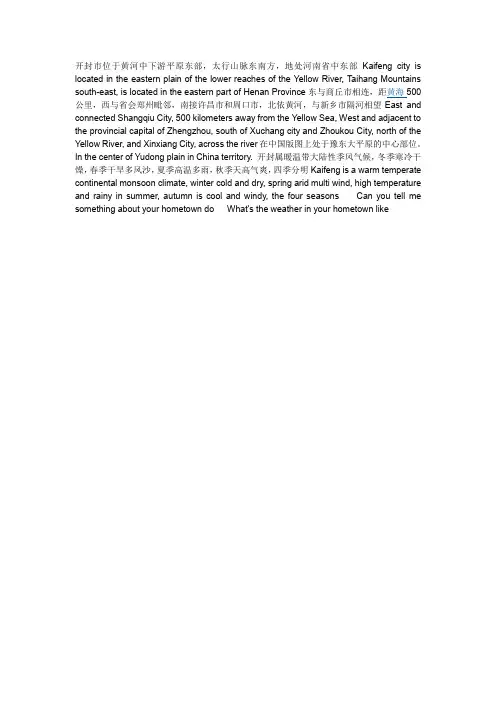
开封市位于黄河中下游平原东部,太行山脉东南方,地处河南省中东部Kaifeng city is located in the eastern plain of the lower reaches of the Yellow River, Taihang Mountains south-east, is located in the eastern part of Henan Province东与商丘市相连,距黄海500公里,西与省会郑州毗邻,南接许昌市和周口市,北依黄河,与新乡市隔河相望East and connected Shangqiu City, 500 kilometers away from the Yellow Sea, West and adjacent to the provincial capital of Zhengzhou, south of Xuchang city and Zhoukou City, north of the Yellow River, and Xinxiang City, across the river在中国版图上处于豫东大平原的中心部位。
In the center of Yudong plain in China territory. 开封属暖温带大陆性季风气候,冬季寒冷干燥,春季干旱多风沙,夏季高温多雨,秋季天高气爽,四季分明Kaifeng is a warm temperate continental monsoon climate, winter cold and dry, spring arid multi wind, high temperature and rainy in summer, autumn is cool and windy, the four seasons Can you tell me something about your hometown do What's the weather in your hometown like。

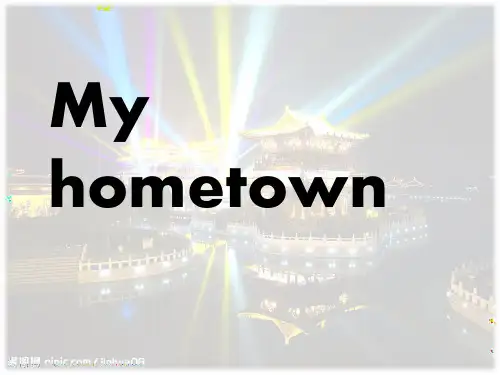

介绍开封的英语作文English:Located in Henan Province, China, Kaifeng is a city rich in history and culture. As one of the Eight Ancient Capitals of China, Kaifeng was once the political, economic, and cultural center of various dynasties, such as the Northern Song Dynasty. The city is famous for its historical sites, such as the Millennium City Park, which showcases the ruins of the ancient city walls and gates. Kaifeng also has a vibrant food scene with local specialties like Kaifeng hot dry noodles, Kaifeng steamed buns, and savory sesame cake. Additionally, the city is home to the Iron Pagoda, a well-preserved architectural marvel from the Song Dynasty, and the Dragon Pavilion, a beautiful imperial palace garden. In recent years, Kaifeng has also prospered as a modern city with developments in industry, technology, and education, making it a dynamic blend of ancient charm and contemporary progress.Translated content:位于中国河南省的开封市是一个充满历史和文化的城市。
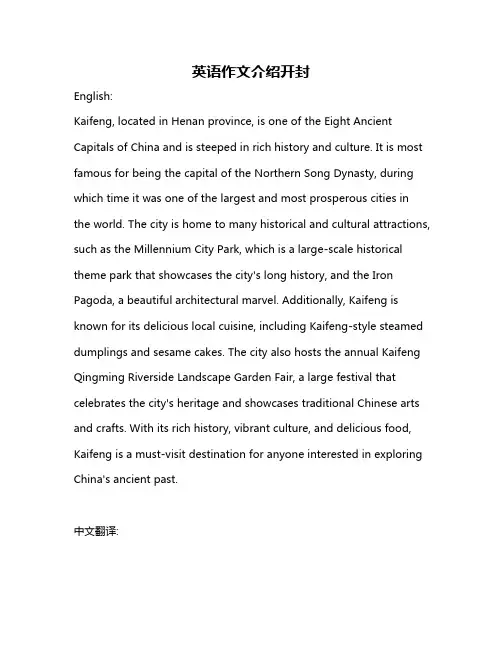
英语作文介绍开封English:Kaifeng, located in Henan province, is one of the Eight Ancient Capitals of China and is steeped in rich history and culture. It is most famous for being the capital of the Northern Song Dynasty, during which time it was one of the largest and most prosperous cities in the world. The city is home to many historical and cultural attractions, such as the Millennium City Park, which is a large-scale historical theme park that showcases the city's long history, and the Iron Pagoda, a beautiful architectural marvel. Additionally, Kaifeng is known for its delicious local cuisine, including Kaifeng-style steamed dumplings and sesame cakes. The city also hosts the annual Kaifeng Qingming Riverside Landscape Garden Fair, a large festival that celebrates the city's heritage and showcases traditional Chinese arts and crafts. With its rich history, vibrant culture, and delicious food, Kaifeng is a must-visit destination for anyone interested in exploring China's ancient past.中文翻译:开封市位于河南省,是中国的八大古都之一,历史文化底蕴深厚。
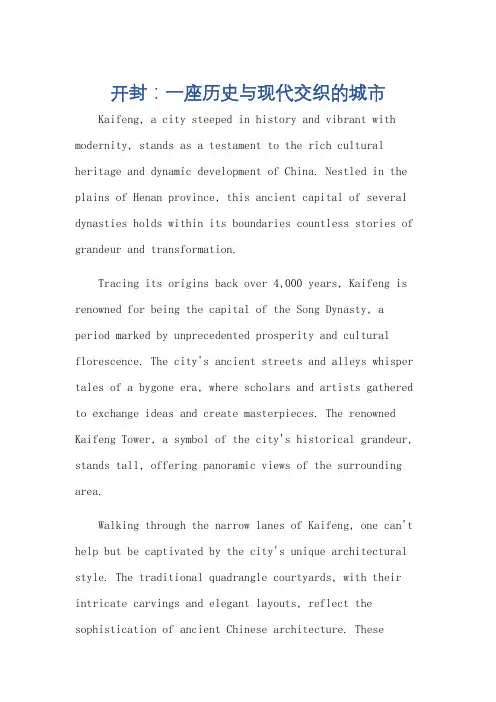
开封:一座历史与现代交织的城市Kaifeng, a city steeped in history and vibrant with modernity, stands as a testament to the rich cultural heritage and dynamic development of China. Nestled in the plains of Henan province, this ancient capital of several dynasties holds within its boundaries countless stories of grandeur and transformation.Tracing its origins back over 4,000 years, Kaifeng is renowned for being the capital of the Song Dynasty, a period marked by unprecedented prosperity and cultural florescence. The city's ancient streets and alleys whisper tales of a bygone era, where scholars and artists gathered to exchange ideas and create masterpieces. The renowned Kaifeng Tower, a symbol of the city's historical grandeur, stands tall, offering panoramic views of the surrounding area.Walking through the narrow lanes of Kaifeng, one can't help but be captivated by the city's unique architectural style. The traditional quadrangle courtyards, with their intricate carvings and elegant layouts, reflect the sophistication of ancient Chinese architecture. Thesecourtyards, often surrounded by high walls and gated entrances, provide a glimpse into the private lives of the city's past elites.Besides its historical charm, Kaifeng is also renowned for its culinary delights. The city is famous for its diverse array of traditional dishes, each with its unique flavor and story. From the savory steamed buns to the delicious dumplings, Kaifeng's cuisine is a testament to the city's rich culinary heritage.In recent years, Kaifeng has undergone significant transformation, embracing modernization while preserving its historical essence. The city's skyline is now dotted with modern high-rises, yet the ancient landmarks and traditions remain intact, creating a harmonious blend of old and new.Moreover, Kaifeng is also a cultural hub, hosting various festivals and events throughout the year. These events, such as the annual Song Cultural Festival, attract thousands of visitors from around the world, eager to experience the city's vibrant cultural scene.In conclusion, Kaifeng is a city that offers a unique blend of history, culture, and modernity. It is a place where the past and the present coexist, creating a captivating tapestry of experiences for visitors to explore. Whether one is fascinated by ancient architecture,delighted by culinary delights, or drawn by the city's vibrant cultural scene, Kaifeng has something for everyone. **开封:一座历史与现代交织的城市**开封,这座承载着厚重历史又洋溢着现代气息的城市,是中国文化遗产与蓬勃发展的生动见证。
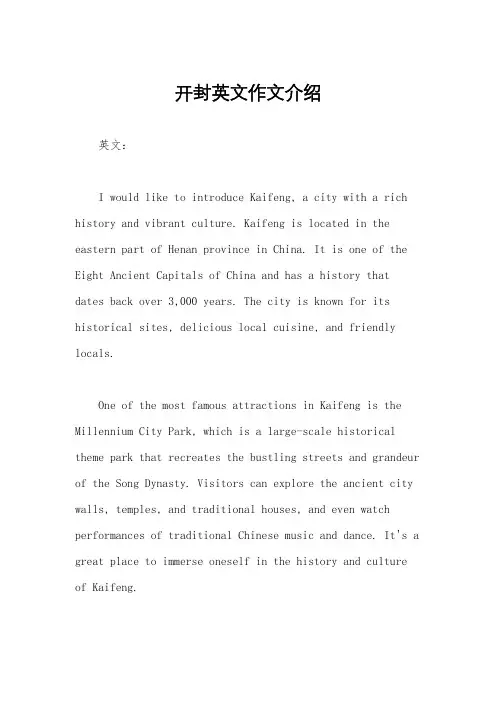
开封英文作文介绍英文:I would like to introduce Kaifeng, a city with a rich history and vibrant culture. Kaifeng is located in the eastern part of Henan province in China. It is one of the Eight Ancient Capitals of China and has a history that dates back over 3,000 years. The city is known for its historical sites, delicious local cuisine, and friendly locals.One of the most famous attractions in Kaifeng is the Millennium City Park, which is a large-scale historical theme park that recreates the bustling streets and grandeur of the Song Dynasty. Visitors can explore the ancient city walls, temples, and traditional houses, and even watch performances of traditional Chinese music and dance. It's a great place to immerse oneself in the history and culture of Kaifeng.Another must-visit spot in Kaifeng is the Iron Pagoda, a 55-meter tall pagoda that was built during the Northern Song Dynasty. The pagoda is made of glazed bricks and is renowned for its intricate designs and exquisite craftsmanship. It's a great place to learn about the architectural achievements of ancient China and enjoy panoramic views of the city from the top.When it comes to food, Kaifeng is famous for its delicious cuisine, especially its traditional snacks. One of the most popular snacks is the Kaifeng-style steamed buns, which are filled with savory meat and steamed to perfection. There are also numerous street food stalls where visitors can try local delicacies such as sesame seed cake, mung bean noodles, and soup dumplings.In terms of the local people, I have found the residents of Kaifeng to be incredibly warm and welcoming. They are always willing to help and are proud to sharetheir city's history and culture with visitors. I remember one time when I got lost in the city, a local resident not only gave me directions but also accompanied me to the busstop to ensure I got on the right bus. It was a small gesture, but it left a lasting impression on me.Overall, Kaifeng is a city that has a lot to offer in terms of history, culture, and hospitality. It's a place where ancient traditions and modern life coexist, and I highly recommend it to anyone looking to experience the authentic charm of China.中文:我想介绍一下开封,这个历史悠久、文化丰富的城市。
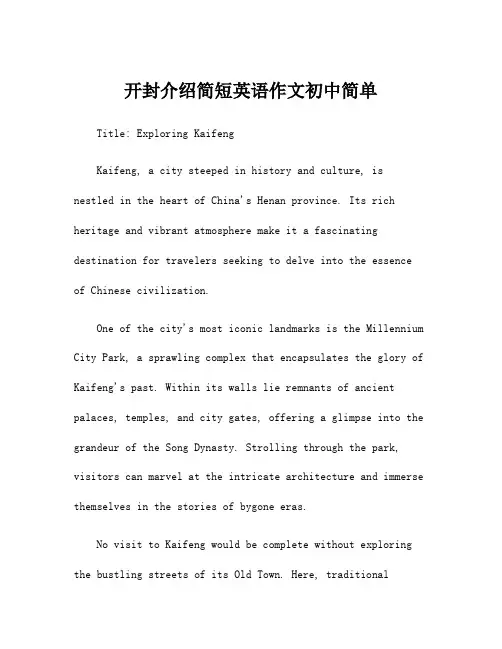
开封介绍简短英语作文初中简单Title: Exploring KaifengKaifeng, a city steeped in history and culture, is nestled in the heart of China's Henan province. Its rich heritage and vibrant atmosphere make it a fascinating destination for travelers seeking to delve into the essence of Chinese civilization.One of the city's most iconic landmarks is the Millennium City Park, a sprawling complex that encapsulates the glory of Kaifeng's past. Within its walls lie remnants of ancient palaces, temples, and city gates, offering a glimpse into the grandeur of the Song Dynasty. Strolling through the park, visitors can marvel at the intricate architecture and immerse themselves in the stories of bygone eras.No visit to Kaifeng would be complete without exploring the bustling streets of its Old Town. Here, traditionalarchitecture mingles with modern amenities, creating a charming juxtaposition of old and new. Wandering through narrow alleyways, one encounters vibrant markets brimming with local delicacies, handicrafts, and souvenirs. The aroma of street food wafts through the air, tempting passersby to sample savory delights such as Bianjing roast duck and steamed buns.For those eager to delve deeper into Kaifeng's past, a visit to the Kaifeng City Museum is a must. Housed within a stately building, the museum showcases a treasure trove of artifacts dating back centuries. From ancient ceramics and calligraphy to intricate jade carvings, each exhibit offers insight into the city's illustrious history and cultural heritage.Beyond its historical attractions, Kaifeng also boasts natural beauty that captivates the senses. The picturesque Yellow River flows gracefully through the outskirts of thecity, offering scenic views and opportunities for leisurely boat rides. Nearby, the serene Dragon Pavilion Park provides a tranquil retreat from the hustle and bustle of urban life, with verdant gardens and tranquil ponds ideal for relaxation and contemplation.In addition to its wealth of historical and natural attractions, Kaifeng is renowned for its vibrant cultural scene. The city comes alive during festivals such as the Qingming Festival and the Lantern Festival, when streets are adorned with colorful decorations and lively performances celebrate age-old traditions.In conclusion, Kaifeng is a city that beckons travelers with its rich tapestry of history, culture, and natural beauty. From ancient landmarks to modern marvels, it offers a diverse array of experiences that leave a lasting impression on all who visit. Whether exploring its storied past orsavoring its culinary delights, a journey to Kaifeng is sure to be an unforgettable adventure.。
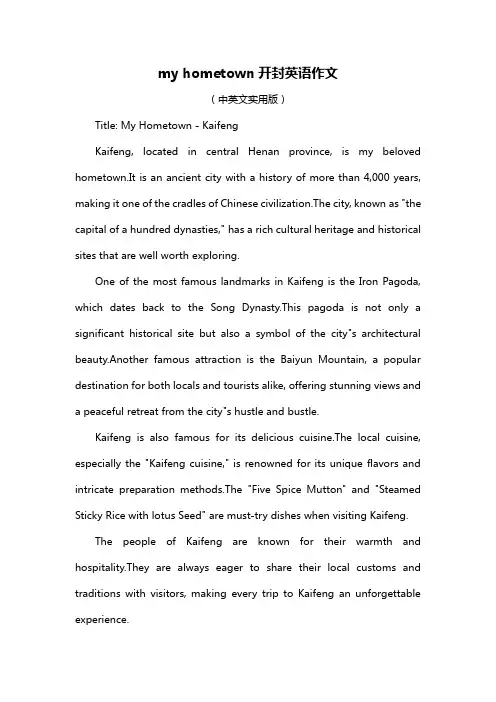
my hometown开封英语作文(中英文实用版)Title: My Hometown - KaifengKaifeng, located in central Henan province, is my beloved hometown.It is an ancient city with a history of more than 4,000 years, making it one of the cradles of Chinese civilization.The city, known as "the capital of a hundred dynasties," has a rich cultural heritage and historical sites that are well worth exploring.One of the most famous landmarks in Kaifeng is the Iron Pagoda, which dates back to the Song Dynasty.This pagoda is not only a significant historical site but also a symbol of the city"s architectural beauty.Another famous attraction is the Baiyun Mountain, a popular destination for both locals and tourists alike, offering stunning views and a peaceful retreat from the city"s hustle and bustle.Kaifeng is also famous for its delicious cuisine.The local cuisine, especially the "Kaifeng cuisine," is renowned for its unique flavors and intricate preparation methods.The "Five Spice Mutton" and "Steamed Sticky Rice with lotus Seed" are must-try dishes when visiting Kaifeng.The people of Kaifeng are known for their warmth and hospitality.They are always eager to share their local customs and traditions with visitors, making every trip to Kaifeng an unforgettable experience.In conclusion, Kaifeng is not only my hometown but also a city with a rich cultural history, stunning landmarks, and delicious cuisine.Whether you"re a history buff, a food lover, or just looking for a place to relax and enjoy the local culture, Kaifeng has something to offer for everyone.。
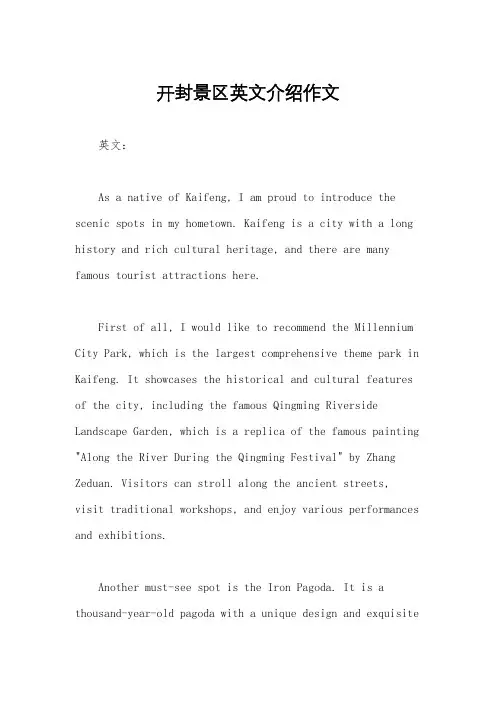
开封景区英文介绍作文英文:As a native of Kaifeng, I am proud to introduce the scenic spots in my hometown. Kaifeng is a city with a long history and rich cultural heritage, and there are many famous tourist attractions here.First of all, I would like to recommend the Millennium City Park, which is the largest comprehensive theme park in Kaifeng. It showcases the historical and cultural features of the city, including the famous Qingming Riverside Landscape Garden, which is a replica of the famous painting "Along the River During the Qingming Festival" by Zhang Zeduan. Visitors can stroll along the ancient streets,visit traditional workshops, and enjoy various performances and exhibitions.Another must-see spot is the Iron Pagoda. It is a thousand-year-old pagoda with a unique design and exquisitecraftsmanship. The pagoda is made of glazed bricks, and its surface is decorated with intricate patterns and sculptures. It is a masterpiece of ancient Chinese architecture and a symbol of Kaifeng's glorious past.In addition, the Dragon Pavilion is also worth visiting. It is a large imperial garden with a history of over 1000 years. The pavilion is surrounded by a tranquil lake, lush gardens, and ancient buildings. It is a great place torelax and enjoy the beautiful scenery.Apart from these famous attractions, there are manyother historical sites, temples, and museums in Kaifengthat are worth exploring. The city's rich history and cultural heritage make it a fascinating destination for travelers who are interested in Chinese history and traditional culture.中文:作为开封的本地人,我很自豪地向大家介绍我家乡的景点。
描述一个非常熟悉的地方开封英语作文English:Every corner of my hometown, Kaifeng, holds a special place in my heart. The smell of steamed buns wafting from the street vendors, the sight of old men playing chess under the ancient pagoda, and the sound of children's laughter echoing through the narrow alleyways, all create a sense of warmth and familiarity that I can't find anywhere else. The bustling night market with its colorful lanterns and lively music, the serene calm of the Longting Park with its weeping willows and tranquil ponds, and the historical richness of the Iron Pagoda and Dragon Pavilion, all remind me of the long history and cultural heritage of this ancient city. Whether it's walking along the ancient city walls, biking through the scenic countryside, or simply enjoying a cup of tea in a traditional teahouse, every moment spent in Kaifeng is a treasure trove of memories that I hold dear.Translated content:我的家乡开封的每一个角落都在我的心中占据着特殊的位置。
欢迎回到河南开封模板作文英文回答:Welcome back to Kaifeng, Henan. Kaifeng, the capital of Henan Province, is a historic and cultural city with a long and rich history. It is located in the central plains of China and has been the capital of many dynasties throughout Chinese history. Kaifeng is also a major economic and cultural center in China today.There are many things to see and do in Kaifeng. Some of the most popular tourist attractions include the Iron Pagoda, the Great Xiangguo Temple, and the Kaifeng City Wall. The Iron Pagoda is a 13-story pagoda that was builtin 1049 AD. It is one of the tallest pagodas in China andis a popular tourist destination. The Great Xiangguo Temple is a Buddhist temple that was built in 550 AD. It is one of the oldest and most important Buddhist temples in China. The Kaifeng City Wall is a city wall that was built in the 14th century AD. It is one of the best-preserved city wallsin China and is a popular tourist destination.Kaifeng is also a great place to try some of the local cuisine. Some of the most popular dishes include Kaifeng roujiamo, scallion oil pancakes, and mutton soup. Kaifeng roujiamo is a type of sandwich that is made with pork belly and a variety of spices. Scallion oil pancakes are a typeof flatbread that is made with scallions and oil. Mutton soup is a type of soup that is made with mutton, vegetables, and spices.If you are looking for a place to stay in Kaifeng,there are many hotels and guesthouses to choose from. Someof the most popular hotels include the Kaifeng Grand Hotel, the Kaifeng International Hotel, and the Kaifeng Century Hotel. These hotels offer a variety of amenities, including swimming pools, fitness centers, and restaurants.Kaifeng is a great place to visit for both tourists and business travelers. There is something for everyone in Kaifeng, from historical and cultural attractions to delicious food and comfortable accommodations.中文回答:欢迎回到河南开封。
我的家乡开封英文作文English:My hometown Kaifeng, located in Henan Province, China, is a city rich in history and culture. Known as one of the Eight Ancient Capitals of China, Kaifeng has a history dating back over 2,700 years. One of the most famous attractions in Kaifeng is the Iron Pagoda, a thousand-year-old architectural wonder. The city is also known for its delicious local cuisine, including Kaifeng-style roast duck and Bianjing dishes. Additionally, Kaifeng is home to the Millennium City Park, an open-air museum showcasing the city's rich history and heritage. With its beautiful scenery and ancient charm, Kaifeng is a place that holds a special place in my heart and one that I am proud to call my hometown.中文翻译:我的家乡开封位于中国河南省,是一个历史悠久,文化丰富的城市。
作为中国八大古都之一,开封有着2700多年的悠久历史。
其中最著名的景点之一是铁塔,这座千年古建筑是开封的标志性景点之一。
介绍故乡开封的英文稿作文My hometown is Kaifeng, a city located in Henan province, China. It is a place full of historical and cultural significance. The first thing that comes to mind when I think about Kaifeng is its rich history. With a history of over 3,000 years, Kaifeng was once the capitalof several dynasties and played a crucial role in shaping the country's development.Walking through the streets of Kaifeng, you can feelthe ancient atmosphere that permeates the city. The old buildings, narrow alleys, and traditional courtyards all contribute to the charm of this place. It's like stepping back in time and experiencing the grandeur of the past.One of the most famous attractions in Kaifeng is the Millennium City Park. It is a large-scale historical theme park that showcases the city's history and culture. Walking through the park, you can see replicas of ancient buildings, experience traditional customs, and even witnessperformances of traditional Chinese opera. It's a great place to immerse yourself in the rich cultural heritage of Kaifeng.Another highlight of Kaifeng is its delicious local cuisine. Kaifeng is known for its variety of snacks and street food. One of the must-try dishes is the Kaifeng Qingming Rice Balls, also known as "Tangyuan." These sticky rice balls are filled with sweet or savory fillings and are a popular treat during the Qingming Festival. The combination of the soft texture and flavorful fillings is simply irresistible.In addition to its historical and culinary attractions, Kaifeng also boasts beautiful natural scenery. The city is surrounded by rivers and lakes, providing a picturesque backdrop for leisurely walks or boat rides. The Yuntai Mountain, located nearby, is a popular destination for hiking and enjoying the breathtaking views of the surrounding landscape.Kaifeng is not only a city with a glorious past butalso a place that embraces modernity. The city has undergone rapid development in recent years, with the construction of modern buildings, shopping malls, and entertainment centers. This blend of old and new creates a unique and dynamic atmosphere that appeals to both locals and visitors.In conclusion, Kaifeng is a city that offers a perfect blend of history, culture, and modernity. Its rich historical heritage, delicious cuisine, beautiful scenery, and vibrant atmosphere make it a place worth exploring. Whether you are interested in history, food, or simply experiencing the charm of an ancient city, Kaifeng has something to offer to everyone.。
对开封的印象英文作文英文:My Impression of Kaifeng。
Kaifeng, what a city it is! Nestled in the heart of Henan province, it's a place that seamlessly blends history with modernity, offering a unique glimpse into China's rich cultural tapestry. My visit to Kaifeng left an indelible mark on me, and here's why.Firstly, let's talk about the historical charm that oozes from every corner of Kaifeng. As I strolled through the narrow lanes of the Old City, I felt like I had been transported back in time. The ancient city walls, remnants of the Song dynasty, stood tall, whispering tales of bygone eras. The bustling streets lined with traditional courtyard houses and vibrant marketplaces painted a vivid picture of life in ancient China.One of the highlights of my trip was exploring the legendary Millennium City Park. Walking through its gates,I was greeted by the sight of the towering Iron Pagoda, a true marvel of architecture. The park's serene lakes, tranquil pavilions, and lush gardens provided a welcome escape from the hustle and bustle of urban life.But Kaifeng isn't just about its historical attractions; it's also a city pulsating with modern energy. The bustling commercial districts, adorned with glittering skyscrapers and neon lights, reflect Kaifeng's status as a dynamic economic hub. From trendy cafes to chic boutiques, the city offers a plethora of options for shopping and dining.Moreover, the warmth and hospitality of the locals added an extra layer of charm to my experience. Whether I was sampling authentic Henan cuisine at a local eatery or bargaining with vendors at the night market, I was always greeted with genuine smiles and friendly banter. It's these small interactions that made me feel welcomed and at homein Kaifeng.In conclusion, my time in Kaifeng was nothing short of unforgettable. The city's rich history, vibrant culture,and modern amenities make it a must-visit destination for anyone looking to explore the heart of China. I've returned home with a treasure trove of memories and a newfound appreciation for this enchanting city.中文:我对开封的印象。